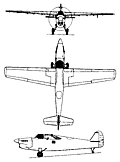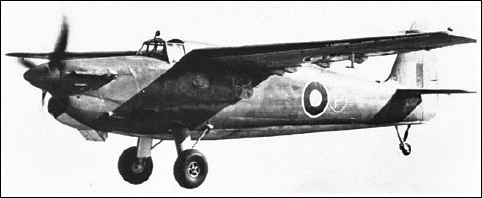|
| Two prototypes, first flown in February 1943. No production.
 | A three-view drawing (752 x 1014) |
| CREW | 3 |
| ENGINE | 1 x 1300hp Rolls-Royce Merlin 30 |
| WEIGHTS |
| Take-off weight | 5448 kg | 12011 lb |
| Empty weight | 4165 kg | 9182 lb |
| DIMENSIONS |
| Wingspan | 15.24 m | 50 ft 0 in |
| Length | 12.19 m | 40 ft 0 in |
| Height | 4.32 m | 14 ft 2 in |
| Wing area | 29.68 m2 | 319.47 sq ft |
| PERFORMANCE |
| Max. speed | 449 km/h | 279 mph |
| Range | 1328 km | 825 miles |
| ARMAMENT | 2 x 7.7mm machine-guns, 6 x 113-kg bombs or a torpedo |
| Anonymous, 01.04.2021 16:20 Nicknamed "Dumbo", this aircraft was built to satisfy the same "Torpedo /Spotter /Reconnaissance" requirement as the Fairey Barracuda. Although it does not show in the photographs, this aircraft was actually equipped with variable incidence wings, which could be controlled by the pilot to increase lift for take-off and landing or decrease drag to increase the aircraft's speed. Oddly, Supermarine figured out a way to to that, but could not figure out a way to retract the landing gear. Another drawback to this design was that, due to the variable incidence wings, it would not have been able to carry any weapons such as rockets, bombs or depth charges beneath the wings. In any event, the Royal Navy had already selected the Barracuda for production before this aircraft ever flew. reply | | Tim Brown, e-mail, 31.01.2018 12:23 S24 /37... that would have been an Air Ministry requirement (the RAF was running the Fleet Air Arm and procuring aircraft up until 1938, and responsible for initiating many of the machines mentioned)... so Oldgysgt is wrong to say "the admirals who were in charge of aircraft procurement had flown nothing more advanced than an oak desk"... it would have been Air Marshals although, of course, the same criticism might apply to their 'Air Ships' reply |
| Oldgysgt, e-mail, 11.01.2016 05:14 When one remembers the obsolete crap that was pawned off on the Royal Navy in the late 1930's and early 1940's,(the Blackburn B-24 Skua and B-25 Roc, the Fairey Swordfish, Albacore, Fulmar and Barracuda), the Supermarine 322 would have been right at home. Clearly the Admirals who were in charge of aircraft procurement for the Royal Navy had flown nothing more advanced than an Oak desk. The brave air crewmen of Britain's senior service deserved better. reply | | Paul, e-mail, 17.05.2012 18:50 The extra mechanism made the aircraft too heavy and it had nasty stalling characteristics at high incidence. (From Eric Brown's book "Wings on my sleeve). reply | |
| | Barry, 15.04.2011 17:17 Specification S24 /37 was the same spec. as the Fairey Barracuda which first flew in 1940. I suspect that this freak could not have been any worse than that freak. reply | | Steve Mcnair, e-mail, 24.11.2010 20:02 "This was a design to meet Specification S.24 /37 for a naval torpedo bomber and reconnaissance plane. Two prototypes were built, carrying the s /ns R1810 and R1815. R1810, as seen on the picture, made its first flight in February 1943. Externally, Type 322 did not show very modern lines with its fixed undercarriage! Most notable feature of the plane, nicknamed 'Dumbo' , was its variable incidence wing which allowed the angle of attack to be changed in-flight by some 15°. The variable incidence mechanism was powered by a small 1.5 hp electric engine. The 'Dumbo' was largely constructed of wood." reply |
|
Do you have any comments?
|
| 
COMPANY
PROFILE
All the World's Rotorcraft
|












The RAF may have framed the requirement for what eventually became the Supermarine 322 in 1937, but the first prototype flew in February 1943, (5 years after the Royal Navy took over aircraft procurement for the Fleet Air Arm). If the Admirals in charge of aircraft procurement for the FAA had known a War Plane from a swivel chair, the Supermarine 322 would have never got off the drawing board. Compare the Supermarine 322, which first flew in 1943, with the Grumman TBF which first flew in 1941, and was in service by 1942; a year before the first Supermarine 322 ever got into the air. So I'm afraid Tim Brown is being too easy on the Royal Navy leadership who were responsible for FAA procurement in the late 1930's and early 1940's.
reply